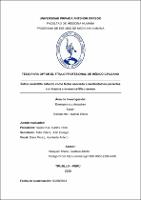| dc.contributor.advisor | Vásquez Tirado, Gustavo Adolfo | |
| dc.contributor.author | Roldan Mori, Nathali Elena | |
| dc.creator | Roldan Mori, Nathali Elena | |
| dc.date.accessioned | 2023-08-11T21:57:58Z | |
| dc.date.available | 2023-08-11T21:57:58Z | |
| dc.date.issued | 2023 | |
| dc.identifier.uri | https://hdl.handle.net/20.500.12759/10989 | |
| dc.description.abstract | El objetivo de este estudio fue determinar si el índice neutrófilo linfocito es un factor asociado a mortalidad en pacientes con trauma craneoencefálico severo. Con la finalidad de establecer un marcador rápido de evolución desfavorable y desenlaces adversos en estos pacientes.
Materiales y métodos: Se realizó un estudio de tipo cohorte retrospectivo, longitudinal en el cual se incluyó 238 pacientes con trauma craneoencefálico severo, que cumplían con los criterios de inclusión establecidos, dichos pacientes se incluyeron en el grupo expuesto o no expuesto hasta completar el tamaño muestral, y luego distinguir a los pacientes cuyo registro informa su fallecimiento hasta en los 28 días del ingreso.
Resultados: El estudio incluyó un total de 238 pacientes, de los cuales 26 (11%) pacientes fallecieron. El índice neutrófilo-linfocito, no mostró una asociación significativa con mortalidad (HR 1.97 IC95% 0.82 – 4.72, valor p>0.5). Sin embargo, en el análisis bivariado y multivariado donde se asoció la intervención de otras variables, se determinó que la presencia de anisocoria aumentaba en 4 veces el riego de muerte (HR 4.1 IC95% 1.86 – 9.04) de forma significativa (valor p<0.001), en el mismo sentido, se determinó que el shock aumentaba en 6 veces el riesgo de muerte (HR 6.64 IC95% 2.49 – 17.73) de forma significativa (valor p<0.001), también, se determinó que la variable hipernatremia incrementó al doble el riesgo de muerte (HR 2.24 IC95% 1.005 – 4.82) de forma significativa (valor p<0.04).
Conclusiones: El índice neutrófilo linfocito elevado no es un factor asociado a mortalidad en pacientes con trauma craneoencefálico severo. | es_PE |
| dc.description.abstract | The objective of this study was to determine if the neutrophil-lymphocyte index is a factor associated with mortality in patients with severe head trauma. In order to establish a rapid marker of unfavorable evolution and adverse outcomes in these patients.
Materials and methods: A longitudinal, retrospective cohort study was carried out, in which 238 patients with severe head trauma were included, who met the established inclusion criteria; these patients were included in the exposed or non-exposed group until completing the sample size, then distinguishing patients whose registry reports their death up to 28 days after admission.
Results: The study included a total of 238 patients, of which 26 (11%) patients died. The neutrophil-lymphocyte index did not show a significant association with mortality (HR 1.97 95% CI 0.82 - 4.72, p>0.5). However, in the bivariate and multivariate analysis where the intervention of other variables was associated, it was determined that the presence of anisocoria increased the risk of death by 4 times (HR 4.1 95% CI 1.86 - 9.04) significantly (p value<0.001 ), in the same sense, it was determined that shock increased the risk of death 6 times (HR 6.64 IC95% 2.49 - 17.73) significantly (p value<0.001), also, it was determined that the hypernatremia variable increased twice the risk of death (HR 2.24 95% CI 1.005 – 4.82) significantly (p value<0.04).
Conclusions: Elevated neutrophil-lymphocyte index is not a factor associated with mortality in patients with severe head injury. | en_US |
| dc.description.uri | Tesis | es_PE |
| dc.format | application/pdf | es_PE |
| dc.language.iso | spa | es_PE |
| dc.publisher | Universidad Privada Antenor Orrego | es_PE |
| dc.relation.ispartofseries | T_MED_3533 | |
| dc.rights | info:eu-repo/semantics/embargoedAccess | es_PE |
| dc.rights.uri | https://creativecommons.org/licenses/by/4.0/ | es_PE |
| dc.source | Universidad Privada Antenor Orrego | es_PE |
| dc.source | Repositorio Institucional - UPAO | es_PE |
| dc.subject | Trauma Craneoencefálico Severo | es_PE |
| dc.subject | Índice Neutrófilo Linfocito | es_PE |
| dc.title | Índice neutrófilo linfocito como factor asociado a mortalidad en pacientes con trauma craneoencefálico severo | es_PE |
| dc.type | info:eu-repo/semantics/bachelorThesis | es_PE |
| thesis.degree.level | Título Profesional | es_PE |
| thesis.degree.grantor | Universidad Privada Antenor Orrego. Facultad de Medicina Humana | es_PE |
| thesis.degree.name | Médico Cirujano | es_PE |
| thesis.degree.discipline | Medicina Humana | es_PE |
| dc.subject.ocde | https://purl.org/pe-repo/ocde/ford#3.02.27 | es_PE |
| renati.advisor.orcid | https://orcid.org/0000-0002-2109-6430 | es_PE |
| renati.author.dni | 72723467 | |
| renati.advisor.dni | 41061921 | |
| renati.type | https://purl.org/pe-repo/renati/type#tesis | es_PE |
| renati.level | https://purl.org/pe-repo/renati/level#tituloProfesional | es_PE |
| renati.discipline | 912016 | es_PE |
| renati.juror | Salas Ruiz, Carlos Efren | |
| renati.juror | Tello Valera, Julio Eulogio | |
| renati.juror | Elera Florez, Humberto Antero | |
| dc.publisher.country | PE | es_PE |
| dc.date.embargoEnd | 2024-08-11 | |




